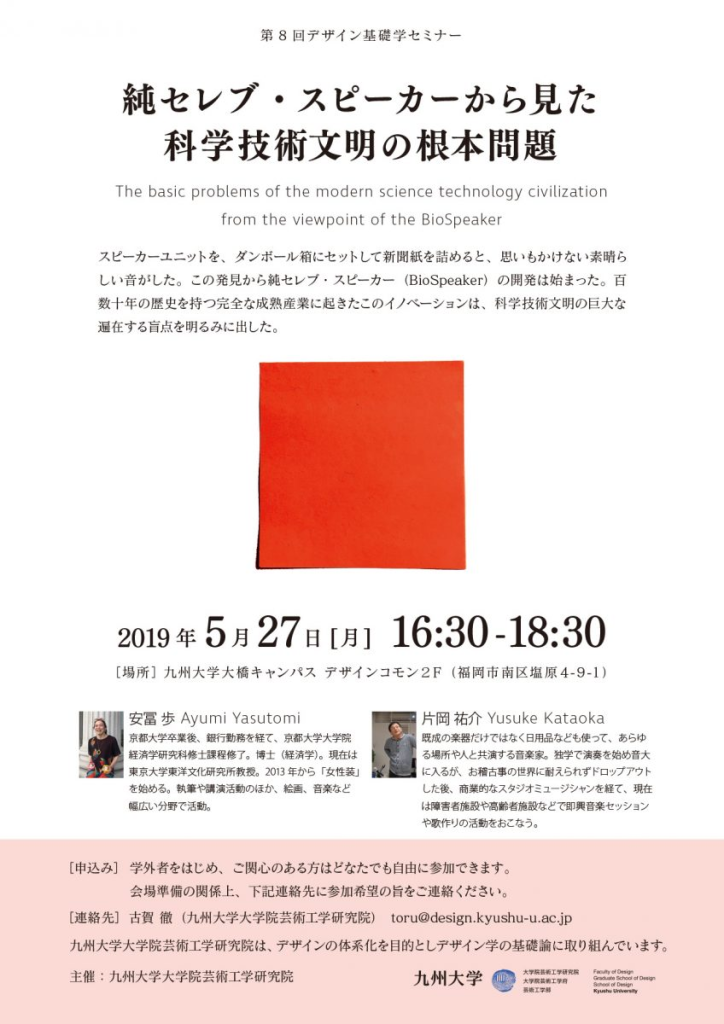The 8th Design Fundamentals Seminar “The basic problems of the modern science technology civilization from the viewpoint of the BioSpeaker”
Who knew a speaker unit placed inside a cardboard box packed with old newspaper could make such an incredible sound? This discovery led to the development of the Pure Celebrity Speaker (BioSpeaker). It’s an innovation born in a fully matured industry with a history of hundreds of years, and exists as a huge, ubiquitous blind spot for today’s science, technology and civilization.
Lecturer
Yusuke Kataoka
A musician who uses not only conventional instruments, but things found in daily life to perform music with all type of places and people. He began as an independent learner before entering a music college but found himself unable to withstand the world of musical practice, so he dropped out and began working as a commercial studio musician. Today he conducts improvisational musical sessions at facilities for the disabled and elderly.
Ayumi Yasutomi
After graduating from Kyoto University worked at a bank before, returning to the university to complete her Ph.D. in economics at the Graduate School of Economics and Faculty of Ecconomics, Kyoto University. She is currently a professor at the University of Tokyo Institute for Advanced Studies on Asia. She started dressing as a woman from 2013, and in addition to writing and public speaking, she also works in a wide range of fields such as painting and music.
Date
May 27th (Monday), 2019, 4:30-6:30 p.m.
Venue
Kyushu University Ohashi Campus, Design Commons 2F

Review
Place a crumpled-up sheet of newspaper inside a cardboard box, open a small hole in the box, and place a wired speaker unit on that hole. With just these simple steps, your cardboard speaker is complete. And this new speaker rings with a surprisingly lively sound.
Ayumi Yasutomi of the University of Tokyo describes this secret as “a mystery”. There isn’t anything in this universe that we understand due to science. Furthermore, we can’t use science to explain why the logic that upholds science itself is correct. This takes root in Wittgenstein’s idea of “what one cannot speak,” and therefore it is a mystery. Humans live inside this ocean of the unknowable and establish their technology on top of it. However, we forget about this, acting like there’s nothing that we can’t explain, trying to keep nature, the events of the world, and even our selves under control.
While Yasutomi continues to expand upon this explanation, beside her, musician Yusuke Kataoka is playfully building a cardboard speaker. With that unit, he plays a recording of a child’s humming. It was a strangely nostalgic song, one that I thought I had never heard before, yet felt strangely familiar. Why does this succession of sounds, ignoring chord progression, somehow become music? It gives me this sense of mystery.
“There is no mystery; there is no mystery anywhere.” The controlled people who fill our surroundings repeat this mantra, suffocating the ones who live. But when the objects that we create are rearranged and put together in a form that we can’t even imagine, from inside that connection, a new “mystery” emerges. Experiences and connections like these give us freedom, breathing new life into us. This is probably the true meaning of technology and the true meaning of design.
To these two, the people that feel this sense of mystery are “blunt celebrities.” The speaker lives and exists in response to people like this. This is because it was freed from a controlled, suppressed state, because the cardboard resonates in unison with the newspaper, creating a brand new, complex vibration, standing on its own and continuing to reverberate. According to Kataoka, music is a very light thing. Technology that has the power to make people light is truly a technology that lives.
(KOGA Toru)




